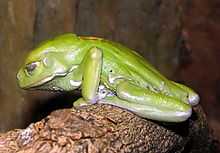Phyllomedusa sauvagii
| Waxy monkey leaf frog | |
|---|---|
 | |
| Conservation status | |
| Scientific classification | |
| Kingdom: | Animalia |
| Phylum: | Chordata |
| Class: | Lissamphibia |
| Order: | Anura |
| Family: | Hylidae |
| Subfamily: | Phyllomedusinae |
| Genus: | Phyllomedusa |
| Species: | P. sauvagii |
| Binomial name | |
| Phyllomedusa sauvagii | |

Phyllomedusa sauvagii, commonly known as the waxy monkey leaf frog, is a hylid frog belonging to the subfamily of South and Central American leaf frogs, Phyllomedusinae, that inhabits the Chaco (dry prairie) of Argentina, Brazil, Bolivia and Paraguay. The subfamily consists of around 50 species in three well-known genera, Phyllomedusa, Agalychnis, and Pachymedusa.[4] The vast majority of known species, including Phyllomedusa sauvagei, belong to the genus Phyllomedusa.
Phyllomedusa sauvagii has adapted to meet the demands of life in the trees. It does not need to return to the ground during the mating season; rather, it lays its eggs down the middle of a leaf before folding the leaf, sandwiching the eggs inside. Its nest is attached to a branch suspended over a stream, so the hatching tadpoles drop into the water.[5] In common with other phyllomedusines, it has physiological and behavioural adaptations to limit water loss, including reducing water loss through the skin by lipid secretions, excretion of uric acid (uricotelism), and diurnal torpor.[6] Lipid secretions are produced in a special type of cutaneous gland, and are spread over the surface of the skin by the legs in a complex sequence of wiping movements.
Males and females range from about 2 to 3 in in length, with the females usually about 25% larger than males. They move by walking rather than hopping, which is the reason for the "monkey" in their name. They are very calm, careful creatures. During the day, they bask in the sun with their legs pulled underneath them, and hunt for various insects at night.
It is often kept as a pet.
Dermorphin
The frogs generate a substance, dermorphin, which has shown up as an illegal performance-enhancing drug in racehorses.
In popular culture
The frog is referenced in the Paul Simon song "Señorita with a Necklace of Tears" on his album You're the One. Simon describes "a frog in South America whose venom is the cure / for all the suffering mankind must endure. / More powerful than morphine, and soothing as the rain, / a frog in South America has the antidote for pain."
References
- ↑ http://www.iucnredlist.org/apps/redlist/details/full/55863/0
- ↑ http://sciencenotes.wordpress.com/2008/09/07/waxy-monkey-frog/
- ↑ http://research.amnh.org/herpetology/amphibia/references.php?id=13504
- ↑ Walls, J.G. (1996) Red-eyes and other leaf-frogs. T.F.H. Publications.
- ↑ Frazer, J.F.D. (1973) Amphibians. Wykeham Publications, London, pp.75.
- ↑ Blaylock, L. A., Ruibal, R. and Platt-Aloia, K. (1976) Skin structure and wiping behavior of Phyllomedusinae frogs. Copeia, 1976: 283–295.
- Article Road: List of All Frog Breeds: Things You Can Do to Ensure Your Frog Has a Long, Happy and Healthy Life: Waxy Monkey Tree Frog
- Aqualand: How to care for your new Waxy Monkey Tree Frog
External links
![]() Data related to Phyllomedusa sauvagii at Wikispecies
Data related to Phyllomedusa sauvagii at Wikispecies
![]() Media related to Phyllomedusa sauvagii at Wikimedia Commons
Media related to Phyllomedusa sauvagii at Wikimedia Commons
